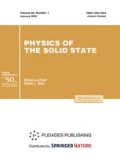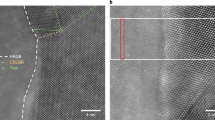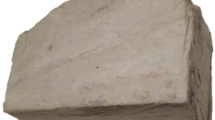Abstract
We obtained a Raman spectrum for a surface layer of porous carbon ceramic (porosity ≈5%) of ≈80 nm thick. The analysis of the spectrum showed that the ceramics contain crystals of silicon carbide 6H‑SiC and silicon. The destruction of ceramics by diamond microcrystals resulted in fractoluminescence (FL). Its spectrum contained two bands at 1.6 and 1.9 eV. The first is emerged at the destruction of silicon crystals, and the second is emerged at 6H-SiC crystals. We obtained the time dependence of the intensity of the fractoluminescence signals with a time resolution of 2 ns. Three types of signals were observed: one is formed when the 6H-SiC crystals are destroyed; the second is formed when silicon crystals are destroyed; the third is formed when these crystals are simultaneously destroyed. The appearance of signals is associated with the formation of cracks arising from the breakthrough of barriers formed at the intersection of slip planes of dislocations in silicon carbide and silicon crystals. The size of cracks in 6H-SiC has been estimated: the smallest is 5.5 nm, and the largest is ≈18 nm.







Similar content being viewed by others
REFERENCES
V. R. Regel’, A. I. Slutsker, and E. E. Tomashevskii, The Kinetic Nature of the Strength of Solids (Nauka, Moscow, 1974) [in Russian].
V. I. Betekhtin and A. G. Kadomtsev, Phys. Solid State 47, 825 (2005).
V. A. Petrov, A. Ya. Bashkarev, and V. I. Vettegren’, Physical Foundations of Predicting the Durability of Structural Materials (Politekhnika, St. Petersburg, 1993) [in Russian].
A. H. Cottrell, Theory of Crystal Dislocations (Gordon and Breach, New York, 1964).
V. I. Vladimirov, The Physical Nature of Metal Destruction (Metallurgiya, Moscow, 1984) [in Russian].
B. Zhang, X. L. Zheng, H. Tokura, and M. Yoshikawa, J. Mater. Proc. Technol. 132, 353 (2003).
Z. Li, F. Zhang, and X. Luo, Appl. Surf. Sci. 448, 341 (2018).
J. Yan, X. Gai, and H. Harada, J. Nanosci. Nanotech. 10 (2010).
V. I. Vettegren’, A. V. Ponomarev, K. Arora, Haris Raza, R. I. Mamalimov, I. P. Shcherbakov, and I. V. Fokin, Phys. Solid State 60, 2300 (2018). https://doi.org/10.1134/S1063783418110355
M. Born and E. Wolf, Principles of Optics, 2nd ed. (Pergamon, Oxford, 1964).
V. I. Vettegren, A. V. Ponomarev, R. I. Mamalimov, and I. P. Shcherbakov, Phys. Solid State 61, 1259 (2019). https://doi.org/10.21883/FTT.2019.07.47844.413
V. I. Vettegren’, A. V. Ponomarev, R. I. Mamalimov, I. P. Shcherbakov, K. Arora, and D. Shrinagesh, Fiz. Zemli, No. 6, 76 (2019). https://doi.org/10.31857/S0002-33372019676-83
V. I. Vettegren’, R. I. Mamalimov, I. P. Shcherbakov, and V. B. Kulik, Phys. Solid State 62, 1210 (2020). https://doi.org/10.1134/S1063783420070276
A. I. Slutsker, A. G. Kadomtsev, V. I. Betekhtin, E. E. Damaskinskaya, and A. B. Sinani, Bull. Russ. Acad. Sci.: Phys. 73, 1410 (2009).
J. Larruquert, A. P. Pérez-Marín, S. García-Cortés, L. Rodríguez-de Marcos, J. A. Aznárez, and J. A. Méndez, J. Opt. Soc. Am. A 28, 2340 (2011).
S. Nakashima and H. Harima, Phys. Status Solidi 162, 39 (1997).
J. P. Russell, Appl. Phys. Lett. 6, 223 (1965). https://doi.org/10.1063/1.1754144
W. Lu, A. T. Tarekegne, Y. Ou, S. Kamiyama, and H. Ou, Sci. Rep. 9, 16333 (2019). https://doi.org/10.1038/s41598-019-52871-6
A. A. Lebedev, Semiconductors 33, 107 (1999).
A. A. Lebedev, N. K. Poletaev, M. G. Rastegaeva, and A. M. Strel’chuk, Semiconductors 28, 981 (1994).
V. A. Zakrevsky and A. V. Shuldiner, Philos. Mag., B 71, 127 (1995).
Author information
Authors and Affiliations
Corresponding author
Ethics declarations
The authors declare that they have no conflicts of interest.
Additional information
Translated by O. Zhukova
Rights and permissions
About this article
Cite this article
Vettegren’, V.I., Kadomtsev, A.G., Shcherbakov, I.P. et al. Formation of Nanoscale Cracks and Fractoluminescence upon Destruction of Carbon Ceramics. Phys. Solid State 62, 2089–2093 (2020). https://doi.org/10.1134/S1063783420110396
Received:
Revised:
Accepted:
Published:
Issue Date:
DOI: https://doi.org/10.1134/S1063783420110396




